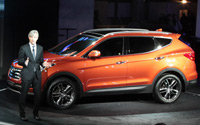 Organizing a bookshelf is a nightmare for the indecisive: you can do it alphabetically by author or title; you can do it by genre; by the size of the
volumes; you can create a Dewey decimal system if you’re a masochist; you could maybe shut your eyes and throw the books at the shelf, I Ching style.
Organizing a bookshelf is a nightmare for the indecisive: you can do it alphabetically by author or title; you can do it by genre; by the size of the
volumes; you can create a Dewey decimal system if you’re a masochist; you could maybe shut your eyes and throw the books at the shelf, I Ching style.
It's kind of the
same thing in the car-naming business: you can do it alpha-numerically (a reshuffle that's in the offing at Infiniti); you can do it by type, style, or size; or by strategy. Hyundai, for example built
a three-row crossover to compete against premium SUV's like Lexus' RX. So, obviously it shoe-horned it into the Veracruz name -- launched in 2006 -- to differentiate it from their more mass market
crossover nameplate, Santa Fe.
advertisement
advertisement
Okay, that makes sense. After all, if you have a luxury crossover, you have to apply a separate name to separate it from the mass market
nameplate. Hyundai did that with Genesis, after all, so why not for a crossover. Genesis, however, was a strikingly different car versus the closest mass market car in the lineup, Sonata, and competes
in a big sandbox -- entry luxury -- one you have to play in if you have designs on the premium market.
But Hyundai was going to market the new Veracruz model against a very
specific set: three-row luxury SUV's. You now have a new name to throw marketing dollars at: a lot of marketing dollars for retail, ad creative, experiential, positioning, etc. A lot of lettuce for
one car.
So Hyundai did something kind of unusual for this kind of conundrum: it refiled the books, eliminating the Veracruz name last year and making the three-row into the
2013 Santa Fe, which went on sale in February.
John Krafcik, president and CEO of Hyundai Motor America tells Marketing Daily, that, first of all, the larger
crossover has enough of a family resemblance to the original Santa Fe (now Santa Fe Sport) to make that work, though the “Storm Edge” design has some cosmetic differences in places like
the hexagonal grill. "The wheelbases of the two Santa Fe's (the larger one has two trim levels) differ by only four inches and they have 80% of their parts in common." The automaker, he notes, has the
same strategy for its four major "super brands,” which, besides Santa Fe, comprises Sonata, which has three variants; Elantra which has three body styles; and Genesis, which comes in two
flavors.
And there's the compact crossover, Tucson, which allows the newly named three-row SUV to fill out a tripartite demographic strategy, notes Krafcik. "Tucson, Santa Fe
and Santa Fe Sport constitute pre-family, family and post family; it now allows us to do targeting segmentation."
Per the automaker, Santa Fe is conquesting about 60% of its
buyers, and that the median owner age is about 57. Also about 31% of buyers of the new Santa Fe (which competes versus Nissan pathfinder, Toyota highlander and Mazda CX-9) are families and only 10%
pre-family. By contrast, 13% of Santa Fe Sport buyers are pre-family and 16% are families.